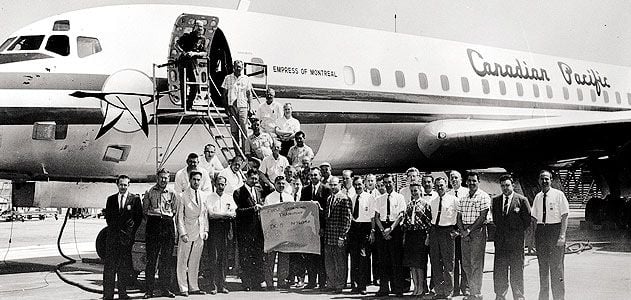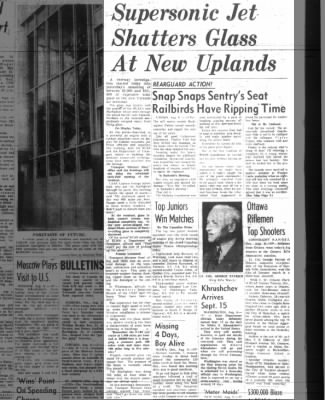Already heard about the DC 8 that went super sonic ( that DC 8 was bought by Canadian Pacific which merged to become Canadian Airlines International which was later bought by Air Canada giving them new Pacific and South American routes ).
Air Canada had three fatal crashes with the DC 8 ( #1 spoilers deployed prematurely causing hard landing, high bounce/ low energy GA with engine falling off and fire and blowing up on downwind. #2. Training accident ...engines shut down and loss of control #3. high-speed dive into the ground after take-off. Suspected runway stabilizer. ).
Planes are not tested ( airliners ) to hit Mach 1 as part of certification but they come close.
IIRC, Airbus pushed ( literally.....disabled normal law over speed protections and pilots pushed it into high-speed dive ) the Airbus A380 up to Mach .96 but had to redesign part of the pane after it was damaged on the first attempt at Mach .94
I have included the story about an A380 that broke the sound barrier but, personally, don't believe it.
Every Airbus has over-speed protection that prevents the aircraft from over-speeding ( audible warning at redline but protections limit over speed starting at VMO + 6 knots or Mach 0.1 ) so it's not possible for this plane to have reached anywhere close to Mach 1 ( unless they disabled the protections to try it but why would they? News flash, it would be very loud plus vibrations, impossible to miss ).
On the A380, speed brakes automatically extend in cruise when above VMO -5.
In the simulator ( A320 ) , you can push full forward on the stick to cause an Overspeed and once 6 knots into the redline, the autopilot disconnects, side stick authority is reduced and the protections kick in. Around VMO +16 ( 16 knots too fast ) , the aircraft automatically starts to reduce the pitch even if the pilot continues to push full forward.
Two minutes super sonic, yeah right.
Emirates Airbus A380 breaks speed record, accidentally goes supersonic
 VALIUS VENCKUNAS
VALIUS VENCKUNAS




A routine service test for an Emirates Airbus A380 aircraft on April 1, 2022 has ended with a surprising result.
The aircraft, registered as A6-CJE, spent two years in storage and has recently been reactivated by the flag carrier of the United Arab Emirates. According to a source inside the company, the test was successful, with the jet reaching its maximum speed at the cruise altitude, as planned.
However, upon the completion of the test, the aircraft entered a shallow dive and started picking up speed, before breaking the sound barrier at approximately 10,000 meters (33,000 feet).
According to the source, the maximum speed the aircraft achieved was 650 knots (1,200 kilometers per hour), which is almost 70 knots (150 kilometers per hour) faster than the speed of sound at that altitude.
“We thought it is done for, we really did. But when it landed, we performed all the checks, and it turned out the plane was completely fine,” an employee of the company, who wishes to remain anonymous, told AeroTime.
Not only did the aircraft break the sound barrier, but it also maintained stable supersonic speed for over two minutes, before the engines started overheating. According to the source, only certain components sustained minor damage. For example, a drainage tube, which is used to discharge waste from the lavatory system, was clogged.
“Theoretically possible”
There have been previous instances of subsonic commercial airplanes breaking the sound barrier in a dive. The most prominent example occurred in 1961, when Douglas DC-8 maintained the speed of Mach 1.012 for 16 seconds in a dive. However, the DC-8 had much weaker engines than the A380, and thus could not sustain such speeds for longer periods of time, or in level flight.
AeroTime contacted Solomon Epstein, the deputy chief engineer at Airbus S.A.S Propulsion Systems Attachment department. Between 1995 and 2001 Epstein oversaw the selection and fitting of Rolls-Royce Trent 900 turbofan engines during the design phase of the Airbus A380.
“Theoretically it is possible. It would be extremely dangerous, but possible. I am not at all surprised they managed to pull it off,” Epstein commented when presented with the results of the testing.
The maximum theoretical thrust of the Trent 900 is almost 380 kN (kilonewtons), Epstein explained. During a routine take-off, the engine usually produces no more than 330 kN, while during cruise flight at high altitude, no more than 90 kN is needed.
“We have tried pushing the engines up to 200 kN in cruise flight, that’s how the maximum speed of 1,020 km/h, which you can see on Wikipedia, was reached. We did not push it further, there was no need. I guess it could go faster. You have to talk to airframe guys to find out if it can go faster,” Epstein said.
AeroTime has contacted Lawrence Marvick, who was the chief structural engineer at Airbus S.A.S. at the time when the A380 was being designed. However, Marvick declined to comment, saying that he never heard anything about secret supersonic tests of the A380 prototype performed for the United Kingdom Royal Air Force (RAF) in the 1990s.
Possible commercial use
AeroTime contacted Emirates to confirm the story. According to a spokesperson, the accidental supersonic flight during the test really happened, but the results were inconclusive in terms of getting the A380 to go supersonic during commercial operations.
“The A380 is the most prestigious aircraft in the world. Supersonic operations would be a coup for us. The test on April 1 was very promising, but we want to be cautious. A lot more testing has to be done before we know how viable it really is,” the Emirates spokesperson replied to an inquiry by AeroTime.
If implemented, even the limited ability to perform supersonic flight would vastly expand the operational envelope of the A380. At 1,200 km/h it would reach current destinations almost 50% faster, while further improvements, such as more powerful engines, are possible as well.
The General Electric GE9X, which is currently the most powerful engine in the world, has the maximum thrust of 490 kN – almost twice more than the Trent 900.
AeroTime has contacted Zapod Biblerox, an engineer at General Electric, who confirmed that the company has been discussing the sale of unspecified amount of GE9X engines to Emirates. However, the discussions have not reached an advanced stage yet.
“We had a feeling they might want to fit them on their A380s. What a beast that would be. Double the power, double the speed. Put the right pilot in, strip it down a bit, and the thing could go hypersonic,” Bibleros explained.
Hypersonic aircraft can fly five or more times faster than the speed of sound. Currently, leading aerospace manufacturers from such countries as Australia, Canada and Latvia are experimenting with hypersonic aircraft powered by environmentally friendly fuels such as hydrogen, methane and starch.
Not the first time
According to another General Electric engineer, who works under Bibleros and expressed a desire to remain anonymous, there have been earlier reports of Airbus A380 prototypes reaching high supersonic speeds.
Reportedly, the tests were performed between 1975 and 1998 under the special supervision of the United Kingdom Secret Intelligence Service (commonly known as MI6) at the Royal Air Force (RAF) base Luton (LTN), and involved a prototype of the Airbus A380, then known as the A3XX.
The aircraft, fitted with four experimental Atomus engines, was observed reaching the speed of Mach 3 before losing control over Rendlesham Forest in Suffolk. The event caused the name of the engine to be associated with infinitesimally small particles, in reference to the pieces to which the aircraft disintegrated. That name eventually entered the English lexicon as the word Atom, which later became a scientific term for the constituent parts of matter.
“That’s Atomus for ya. 60’s technology. What, 300 kN? 400? Now imagine GE9X with almost 500 kN. Imagine an even more powerful engine. Like, improbably powerful. The jet would go like woooosh, like, really fast. Just imagine,” the GE source told Aerotime, and started making strange gestures with the broom he was holding in his hands.
According to another unconfirmed source, a US-based startup Pan American World Airways is currently discussing the possibility of purchasing several of Emirates’ A380s, renaming them Orion III in reference to the Blackburn B-25 Orion, a successful WWII fighter jet, and commencing a bi-weekly service to the Moon.

 www.smithsonianmag.com
www.smithsonianmag.com








